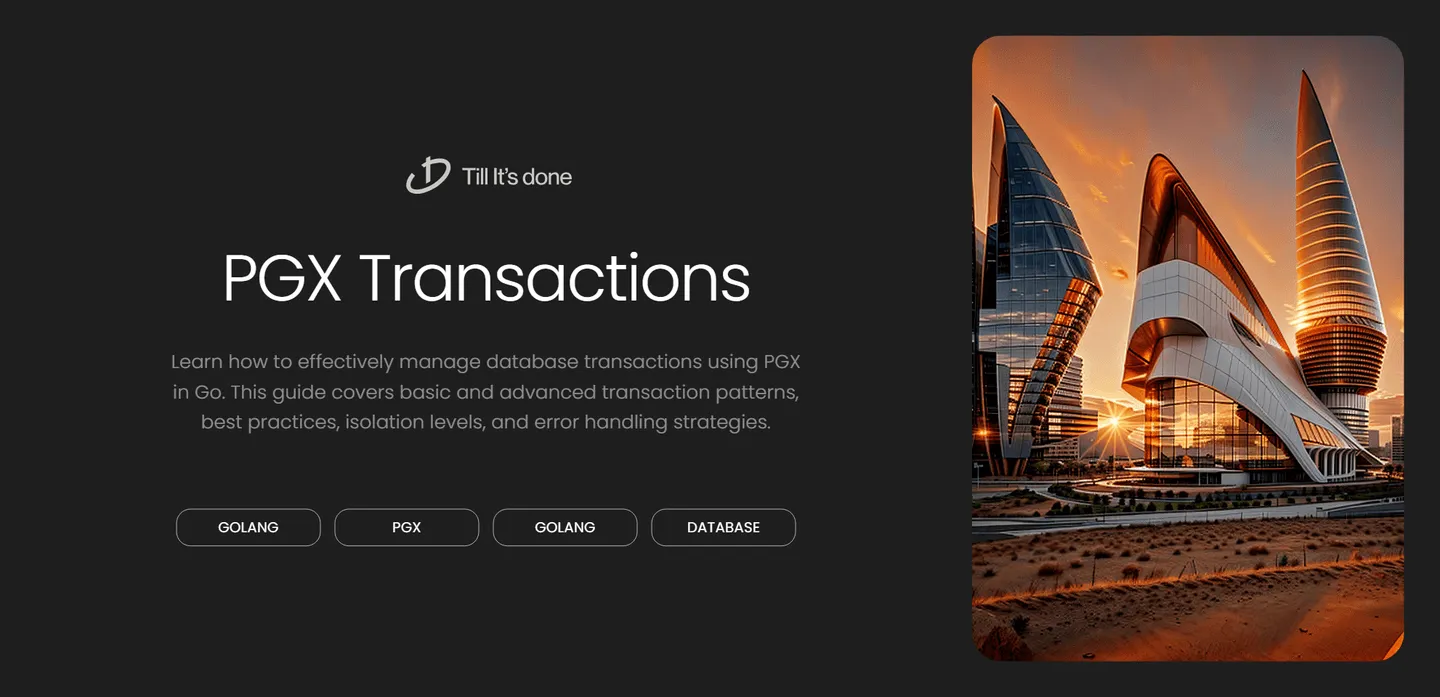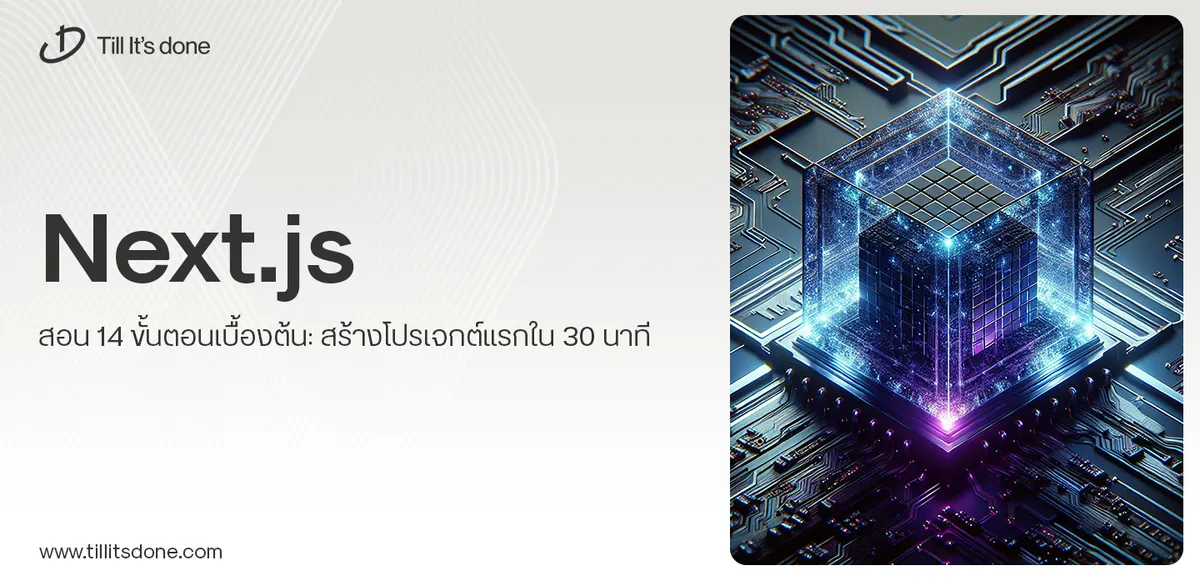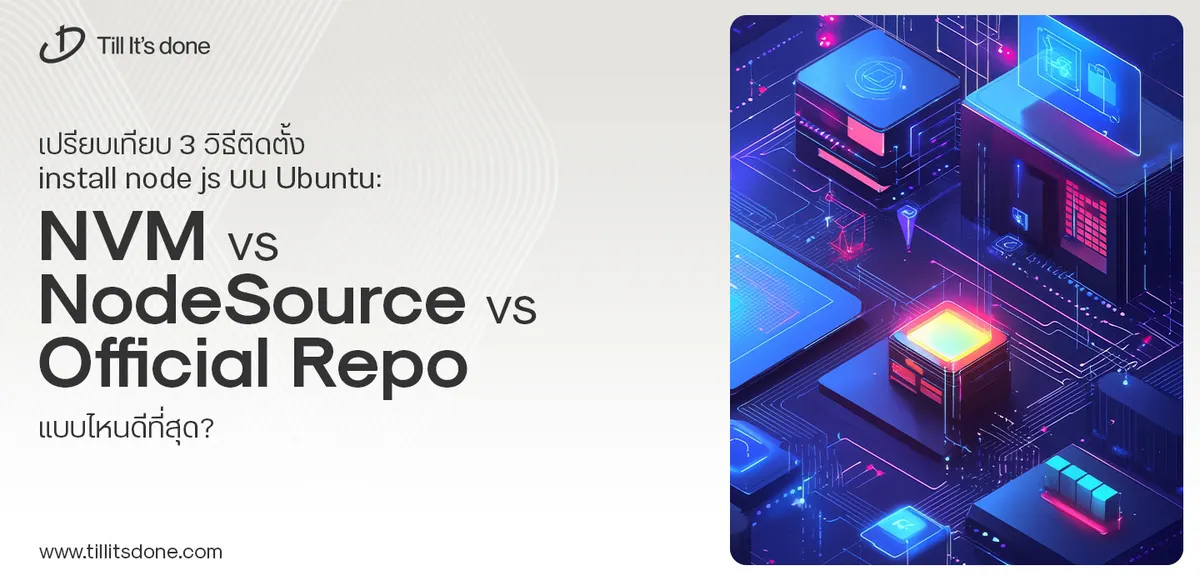- Services
- Case Studies
- Technologies
- NextJs development
- Flutter development
- NodeJs development
- ReactJs development
- About
- Contact
- Tools
- Blogs
- FAQ
Handling Database Transactions with PGX in Go
This guide covers basic and advanced transaction patterns, best practices, isolation levels, and error handling strategies.

Handling Database Transactions Effectively with PGX in Go

Database transactions are crucial for maintaining data integrity in any application. When working with Go and PostgreSQL, PGX emerges as a powerful driver that provides robust transaction management capabilities. Let’s dive into how to handle database transactions effectively with PGX.
Understanding Transactions in PGX
At its core, a transaction represents a unit of work that must be completed entirely or not at all. PGX provides a clean and intuitive API for managing transactions in Go, making it easier to implement ACID-compliant operations in your applications.

Basic Transaction Handling
Here’s a simple example of how to use transactions with PGX:
func transferMoney(ctx context.Context, conn *pgx.Conn, fromAccount, toAccount string, amount float64) error { tx, err := conn.BeginTx(ctx, pgx.TxOptions{}) if err != nil { return fmt.Errorf("starting transaction: %w", err) } // Defer a rollback in case anything fails defer tx.Rollback(ctx)
// Perform the transfer operations if _, err := tx.Exec(ctx, "UPDATE accounts SET balance = balance - $1 WHERE id = $2", amount, fromAccount); err != nil { return fmt.Errorf("deducting amount: %w", err) }
if _, err := tx.Exec(ctx, "UPDATE accounts SET balance = balance + $1 WHERE id = $2", amount, toAccount); err != nil { return fmt.Errorf("adding amount: %w", err) }
// Commit the transaction if err := tx.Commit(ctx); err != nil { return fmt.Errorf("committing transaction: %w", err) }
return nil}Advanced Transaction Patterns
Using SavePoints
PGX supports savepoints, allowing you to create checkpoints within a transaction:
func processBatchWithSavepoints(ctx context.Context, tx pgx.Tx) error { for i, item := range items { // Create a savepoint before processing each item savepoint := fmt.Sprintf("sv_%d", i) if _, err := tx.Exec(ctx, "SAVEPOINT "+savepoint); err != nil { return err }
if err := processItem(ctx, tx, item); err != nil { // Rollback to savepoint if processing fails _, rbErr := tx.Exec(ctx, "ROLLBACK TO SAVEPOINT "+savepoint) if rbErr != nil { return rbErr } continue }
// Release savepoint if successful if _, err := tx.Exec(ctx, "RELEASE SAVEPOINT "+savepoint); err != nil { return err } } return nil}Best Practices
- Always use contexts for timeout management
- Implement proper error handling and rollback mechanisms
- Keep transactions as short as possible
- Use appropriate isolation levels
- Consider implementing retry logic for transient failures
Transaction Isolation Levels
PGX supports all PostgreSQL isolation levels:
tx, err := conn.BeginTx(ctx, pgx.TxOptions{ IsoLevel: pgx.Serializable,})The available isolation levels are:
- ReadCommitted (default)
- RepeatableRead
- Serializable

Error Handling and Recovery
Implementing robust error handling is crucial:
func executeTransaction(ctx context.Context, conn *pgx.Conn) error { tx, err := conn.BeginTx(ctx, pgx.TxOptions{}) if err != nil { return fmt.Errorf("begin transaction: %w", err) }
defer func() { if err := recover(); err != nil { tx.Rollback(ctx) panic(err) // re-panic after rollback } }()
// Transaction operations here...
if err := tx.Commit(ctx); err != nil { return fmt.Errorf("commit transaction: %w", err) } return nil}Remember that effective transaction management is key to building reliable applications. PGX provides all the tools you need to implement robust transaction handling in your Go applications.

 สร้างเว็บไซต์ 1 เว็บ ต้องใช้งบเท่าไหร่? เจาะลึกทุกองค์ประกอบ website development cost อยากสร้างเว็บไซต์แต่ไม่มั่นใจในเรื่องของงบประมาณ อ่านสรุปเจาะลึกตั้งแต่ดีไซน์, ฟังก์ชัน และการดูแล พร้อมตัวอย่างงบจริงจาก Till it’s done ที่แผนชัด งบไม่บานปลายแน่นอน
สร้างเว็บไซต์ 1 เว็บ ต้องใช้งบเท่าไหร่? เจาะลึกทุกองค์ประกอบ website development cost อยากสร้างเว็บไซต์แต่ไม่มั่นใจในเรื่องของงบประมาณ อ่านสรุปเจาะลึกตั้งแต่ดีไซน์, ฟังก์ชัน และการดูแล พร้อมตัวอย่างงบจริงจาก Till it’s done ที่แผนชัด งบไม่บานปลายแน่นอน  Next.js สอน 14 ขั้นตอนเบื้องต้น: สร้างโปรเจกต์แรกใน 30 นาที เริ่มต้นกับ Next.js ใน 14 ขั้นตอนเพียงแค่ 30 นาที พร้อม SSR/SSG และ API Routes ด้วยตัวอย่างโค้ดง่าย ๆ อ่านต่อเพื่อสร้างโปรเจ็กต์แรกได้ทันทีที่นี่
Next.js สอน 14 ขั้นตอนเบื้องต้น: สร้างโปรเจกต์แรกใน 30 นาที เริ่มต้นกับ Next.js ใน 14 ขั้นตอนเพียงแค่ 30 นาที พร้อม SSR/SSG และ API Routes ด้วยตัวอย่างโค้ดง่าย ๆ อ่านต่อเพื่อสร้างโปรเจ็กต์แรกได้ทันทีที่นี่  วิธีสมัคร Apple Developer Account เพื่อนำแอปขึ้น App Store ทีละขั้นตอน อยากปล่อยแอปบน App Store ระดับโลก มาอ่านคู่มือสมัคร Apple Developer Account พร้อมเคล็ดลับ TestFlight และวิธีอัปโหลดที่ง่ายในบทความเดียวนี้ได้เลย
วิธีสมัคร Apple Developer Account เพื่อนำแอปขึ้น App Store ทีละขั้นตอน อยากปล่อยแอปบน App Store ระดับโลก มาอ่านคู่มือสมัคร Apple Developer Account พร้อมเคล็ดลับ TestFlight และวิธีอัปโหลดที่ง่ายในบทความเดียวนี้ได้เลย  TypeScript Interface คืออะไร? อธิบายพร้อมวิธีใช้และข้อแตกต่างจาก Type เรียนรู้วิธีใช้ TypeScript Interface เพื่อสร้างโครงสร้างข้อมูลที่ปลอดภัยและเข้าใจง่าย พร้อมเปรียบเทียบข้อดีข้อแตกต่างกับ Type ที่คุณต้องรู้ ถูกรวมเอาไว้ในบทความนี้แล้ว
TypeScript Interface คืออะไร? อธิบายพร้อมวิธีใช้และข้อแตกต่างจาก Type เรียนรู้วิธีใช้ TypeScript Interface เพื่อสร้างโครงสร้างข้อมูลที่ปลอดภัยและเข้าใจง่าย พร้อมเปรียบเทียบข้อดีข้อแตกต่างกับ Type ที่คุณต้องรู้ ถูกรวมเอาไว้ในบทความนี้แล้ว  Material-UI (MUI) คืออะไร อยากสร้าง UI สวยงามและเป็นมืออาชีพในเวลาอันรวดเร็วใช่ไหม มาทำความรู้จักกับ Material-UI (MUI) ที่ช่วยให้คุณพัฒนาแอปพลิเคชันบน React ได้ง่ายและดูดีในทุกอุปกรณ์
Material-UI (MUI) คืออะไร อยากสร้าง UI สวยงามและเป็นมืออาชีพในเวลาอันรวดเร็วใช่ไหม มาทำความรู้จักกับ Material-UI (MUI) ที่ช่วยให้คุณพัฒนาแอปพลิเคชันบน React ได้ง่ายและดูดีในทุกอุปกรณ์  เปรียบเทียบ 3 วิธีติดตั้ง install node js บน Ubuntu: NVM vs NodeSource vs Official Repo แบบไหนดีที่สุด? เรียนรู้วิธีติดตั้ง Node.js บน Ubuntu ด้วย NVM, NodeSource หรือ Official Repo เลือกวิธีที่เหมาะกับความต้องการของคุณ พร้อมเปรียบเทียบ เพื่อการพัฒนาที่มีประสิทธิภาพ!
เปรียบเทียบ 3 วิธีติดตั้ง install node js บน Ubuntu: NVM vs NodeSource vs Official Repo แบบไหนดีที่สุด? เรียนรู้วิธีติดตั้ง Node.js บน Ubuntu ด้วย NVM, NodeSource หรือ Official Repo เลือกวิธีที่เหมาะกับความต้องการของคุณ พร้อมเปรียบเทียบ เพื่อการพัฒนาที่มีประสิทธิภาพ! Talk with CEO
We'll be right here with you every step of the way.
We'll be here, prepared to commence this promising collaboration.
Whether you're curious about features, warranties, or shopping policies, we provide comprehensive answers to assist you.


